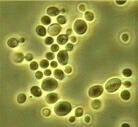
Annotated and Non-Annotated Gene Comparison in Yeast

Figure 1. This is a view of Saccharomyces cerevisiae, or baker's yeast (http://helios.bto.ed.ac.uk/bto/microbes/yeast.htm). Seeking permission from The Microbial World at The University of Edinburgh.
"This web page was produced as an assignment for an undergraduate course at Davidson College."
Annotated Yeast Gene FUS1
Standard Name of Gene: FUS1
Systematic Name of Gene: YCL027W
Location of gene in yeast genome: Chromosome III, coordinates 71803 to 73341The gene accession number is NC_001135. The gene contains 316613 bp of DNA.
The protein accession number is CAA42358. The protein is composed of 512 amino acids.
The preceding factual information was accessed from (http://genome-www4.stanford.edu/cgi-bin/SGD/locus.pl?locus=FUS1)
Function
A pheromone is a small volatile chemical signal that functions in the communication between animals and acts much like a hormone in influencing physiology and behavior. In other words, pheromones function like a hormone with the important exception that a pheromone coordinates communication between animals of the same species and not the parts of a single animal's body (Campbell, 1996). Mating in yeast, through conjugation, is mediated by pheromones. This is referred to as chemotropic mating. As yeast cells of opposite mating type are mixed, they secrete their pheromone. Each responds to the pheromone of the opposite mating type by differentiating into a specialized gamete that has haploid nuclei. The cells then respond by changing their shape into a pear shape with one end elongated. This characteristic shape has been termed "shmoo". Cells of opposite mating type that are close together will fuse at the small end of the shmoo and the haploid nucleus within each parent cell will fuse into a diploid nucleus. The cell then buds at the constriction (http://www.phys.ksu.edu/gene/a1.html).
Haploid Saccharomyces cerevisiae cells find each other during conjugation by orientating their growth into the shmoo shape along pheromone gradients. Once their receptors are saturated with pheromone binding, yeast cells must select a mate through a default pathway in which the cell must choose a partner at random. The FUS1 gene is one gene required for this default pathway (Dorer et al.,1997, http://www.ncbi.nlm.nih.gov/entrez/query.fcgi?cmd=Retrieve&db=PubMed&list_uids=9135999&dopt=Abstract).
The product of FUS1 is required for efficient cell fusion during conjugation. In addition, FUS1 is important for the localization of vesicles to the cell fusion zone. Thus, FUS1 is required for zygote formation (http://www.proteome.com/databases/YPD/reports/FUS1.html).
Localization
The FUS1 fusion protein is localized to the tip of the mating projection in the cell membrane. Membrane fractionation experiments indicate that the FUS1 protein spans the plasma membrane (Trueheart et al., 1989, http://www.ncbi.nlm.nih.gov/entrez/query.fcgi?cmd=Retrieve&db=PubMed&list_uids=2690078&dopt=Abstract).
Mutant Phenotype
A null mutation in FUS1 leads to a viable yeast cell. Yet mating efficiency is affected by this mutation because of a defect in cell fusion. The partition between the two yeast cells remains undissolved. The two yeast cells do not adhere tightly and so there is no mixing of organelles. The zygote formed appears abnormal (McCaffrey et al., 1987, http://www.ncbi.nlm.nih.gov/entrez/query.fcgi?cmd=Retrieve&db=PubMed&list_uids=3313002&dopt=Abstract). There is evidence that mating through the default pathway, in which FUS1 has a role, places a more stringent requirement on some aspects of cell fusion than chemotropic mating. Thus, a mutation would have an effect on efficiency of mating via the default pathway (Dorer et al., 1997, http://www.ncbi.nlm.nih.gov/entrez/query.fcgi?cmd=Retrieve&db=PubMed&list_uids=9135999&dopt=Abstract).
A mutation in FUS1 appears to be recessive. Fusion is only moderately impaired when the two parents have one or two mutated genes, and fusion is severely affected when three or all four genes are inactivated (http://www.proteome.com/databases/YPD/reports/FUS1.html).
Non-Annotated Yeast Gene
Systematic Name: YCLO48W
Description: Hypothetical ORF
Location of ORF in genome: Chromosome III, coordinates 42165 to 43556
The gene accession number is NC_001135. This gene contains 316613 bp of DNA.
The hypothetical protein accession number is NP_009882. This is composed of 463 amino acids (http://www.ncbi.nlm.nih.gov/entrez/query.fcgi?cmd=Retrieve&db=Protein&list_uids=06319801&dopt=GenPept).
Molecular function and biological process unknown.
After performing a Kyte-Doolittle analysis, there does appear to be a transmembrane domain as evidence by the peaks above 2 on the y-axis (http://fasta.bioch.virginia.edu/fasta/grease.htm).

Figure 2. Kyte-Doolittle graph generated from protein sequence. (http://fasta.bioch.virginia.edu/fasta/grease.htm)
After doing a search at the PREDATOR website, the secondary structure of the protein was predicted to have several alpha helices, many random coils, and extended strands (http://npsa-pbil.ibcp.fr/cgi-bin/npsa_automat.pl?page=/NPSA/npsa_predator.html).
Since this gene is on the same chromosome as several other genes involved in mating, I predict that the encoded protein is also involved in this process. Since the protein appears to be transmembrane, I predict the protein to be involved in the conjugation process where membranes fuse or in the process of pheromone release in which vesicles must be excreted into the area surrounding the yeast cell.
References
Campbell, N.A. 1996. Biology. 4th ed. Menlo Park: Benjamin/Cummings Publishing, 914.
Dorer, R., C. Boone, T. Kimbrough, J. Kim, and, L.H. Hartwell. 1997. Genetic analysis of default mating behavior in Saccharomyces cerevisiae. Genetics. Vol. 146: 39-55.
<http://fasta.bioch.virginia.edu/fasta/grease.htm> Accessed 30 September.
<http://genome-www4.stanford.edu/cgi-bin/SGD/locus.pl?locus=FUS1> Accessed 30 September.
McCaffrey G., F.J. Clay, K. Kelsay, and G.F. Sprague. 1987. Identification and regulation of a gene required for cell fusion during mating of the yeast Saccharomyces cerevisiae. Molecular Cell Biology. Vol. 7: 2680-90.
<http://www.ncbi.nlm.nih.gov/entrez/query.fcgi?cmd=Retrieve&db=Protein&list_uids=06319801&dopt=GenPept> Accessed 30 September.
<http://npsa-pbil.ibcp.fr/cgi-bin/npsa_automat.pl?page=/NPSA/npsa_predator.html> Accessed 30 Spetember.
<http://www.phys.ksu.edu/gene/a1.html> Accessed 30 September.
<http://www.proteome.com/databases/YPD/reports/FUS1.html> Accessed 30 September.
Trueheart, J.and G.R. Fink. 1989. The yeast cell fusion protein FUS1 is O-glycosylated and spans the plasma membrane. Proc Natl Acad Sci. Vol. 86: 9916-20.
http://www.ncbi.nlm.nih.gov/entrez/query.fcgi?cmd=Retrieve&db=Protein&list_uids=06319801&dopt=GenPept
For questions or comments contact elsellars@davidson.edu